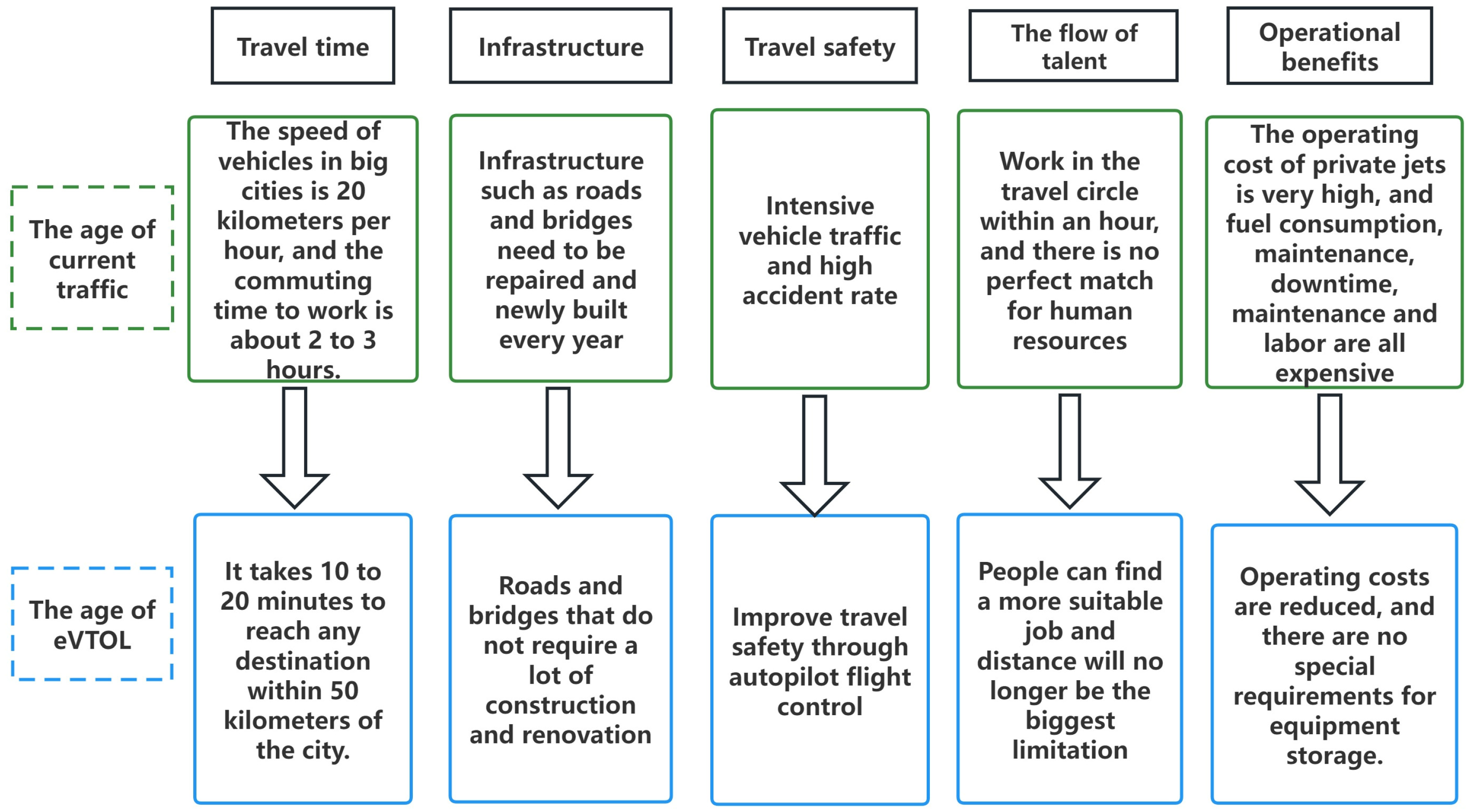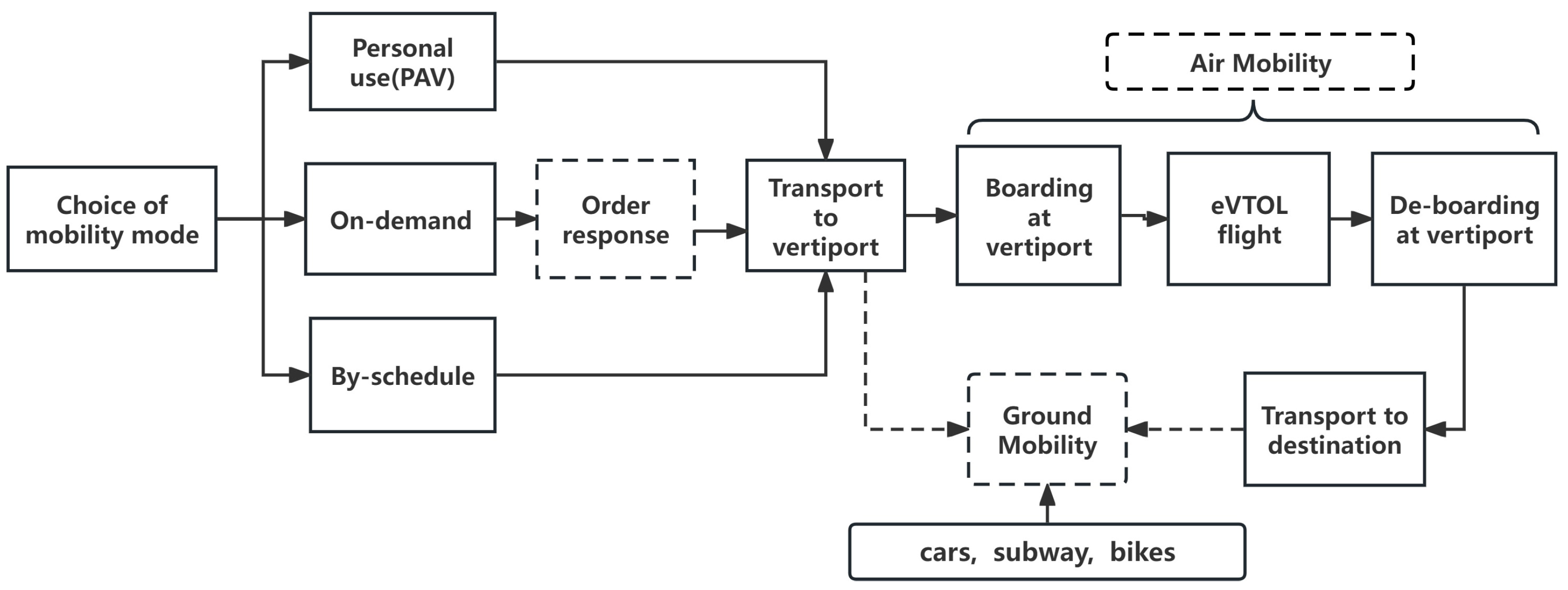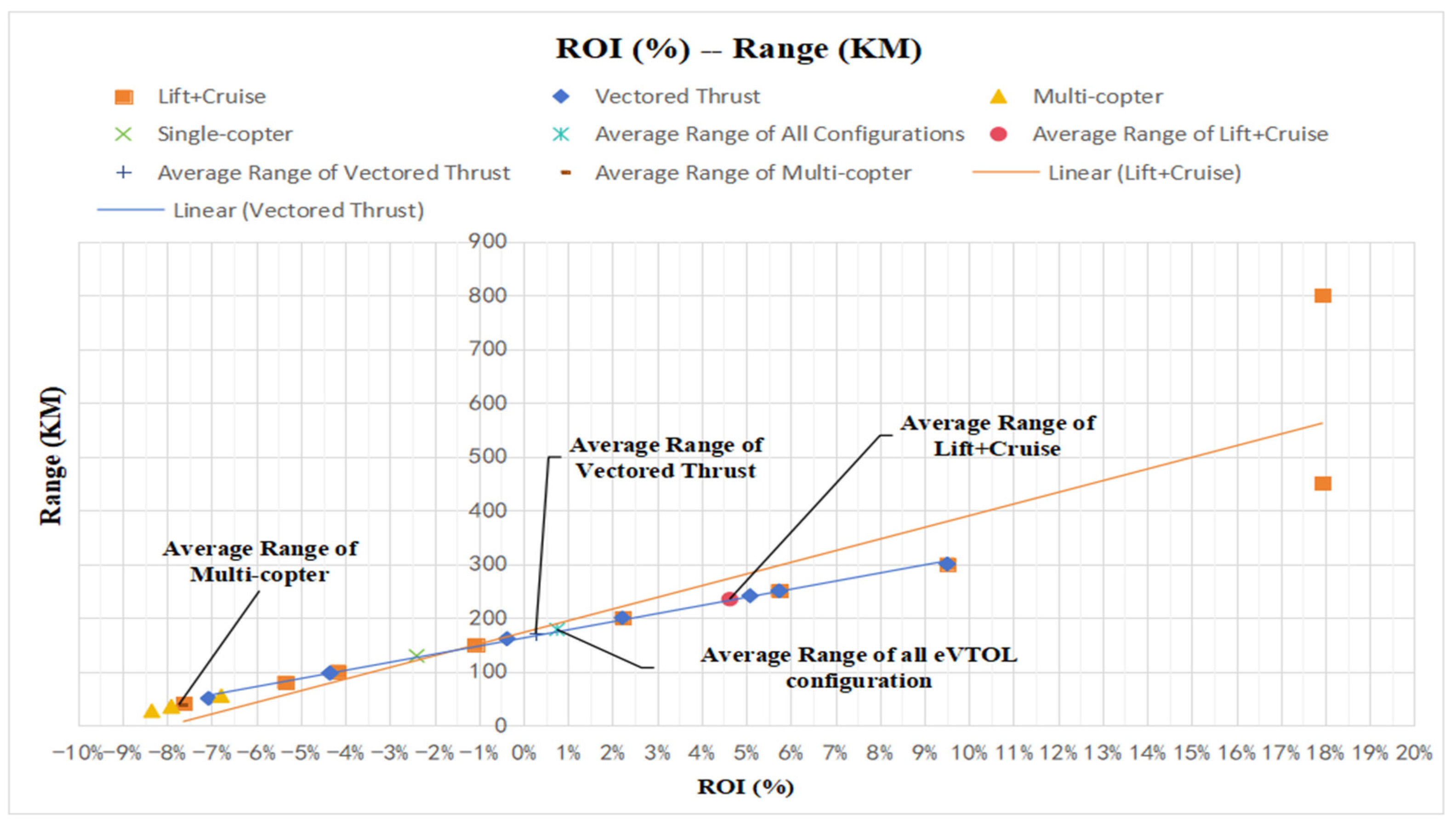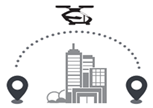Assessing Electric Vertical Take-Off and Landing for Urban Air Taxi Services: Key Parameters and Future Transportation Impact
Abstract
1. Introduction
2. Literature Review
2.1. Establishing a New Transportation System in Upper Urban Space
2.2. The Potential Effect of eVTOL
2.3. Engineering Application and Economic Feasibility
2.4. Modeling of eVTOL Configurations
2.5. eVTOL Flying Mechanisms
3. Results
3.1. Determining Total Operating and Support Costs
3.2. Generic Revenue and Operating Cost Modeling
3.2.1. Model Version 1
3.2.2. Model Version 2
3.3. Model Processing
3.3.1. Estimating Revenue
3.3.2. Estimating O&S
3.4. Maximum Voyage of eVTOL Flying Mechanisms
- (1)
- When adopting the average range of all eVTOL configurations currently on the electric aviation market, the modeling results preliminarily show that an air taxi service using eVTOL aircraft can be profitable after commercial operation. The return on investment is considerable, with an estimated ROI of about 0.8% in a quarter and 3.2% in a year.
- (2)
- For vectored thrust and lift and cruise configurations, the average range yields an ROI greater than zero, indicating profitability. The lift and cruise mechanism demonstrates particularly good performance in commercial operation. The estimated ROI for vectored thrust is 0.3% in a quarter and 1.2% in a year, while for lift and cruise, it is 4.6% in a quarter and 18.4% in a year. For these configurations, rapid battery charging technology could be applied to improve flight operation efficiency.
- (3)
- For multi-copter and single-copter configurations, the ROI is lower than zero, suggesting a lack of profitability. The voyage range of the multi-copter eVTOL configuration is within 30 km to 55 km. To continue the 40 km per flight mission for multi-copters, battery swapping technology should be implemented after each single flight.
3.5. Price of eVTOL per Kilometer
4. Discussion
5. Conclusions
Author Contributions
Funding
Institutional Review Board Statement
Informed Consent Statement
Data Availability Statement
Conflicts of Interest
References
- Ma, Z.; Jiang, H.; Ma, Z.; Zhang, S.; Zhang, T.; Li, L. Research on Urban air public transport system design. Chinese Aeronautical Society. Proc. China Aeronaut. Soc. Youth Sci. Technol. Forum 2016, 2, 301–305. [Google Scholar]
- Sumathy, E.; Bosco, M.A.J. A study on traffic forecast for metro railway expansion in Chennai. Indian J. Sci. Technol. 2016, 9, 1–10. [Google Scholar] [CrossRef]
- Yang, G. Analysis of Shanghai Urban Traffic Congestion and Countermeasures and Suggestions. Available online: https://kns.cnki.net/KCMS/detail/detail.aspx?dbname=CMFD2009&filename=2009020621.nh (accessed on 25 December 2023).
- Cao, C. Design conception of urban air passenger transportation system. Transp. Port Shipp. 2021, 8, 39–44. [Google Scholar]
- Sun, R. Changing the Mode of Urban Transportation in the Future—On Airbus UAM Project. Sci. Technol. Inf. 2019, 17, 180–181. [Google Scholar]
- Wang, Q. Solving the problem of traffic congestion in big cities with a new way of thinking—Interview with Guo Jifu, member of the National Committee of the Chinese People’s Political Consultative Conference and president of the Beijing Institute of Transportatio. Econ. Trib. Sustain. Dev. 2020, 7, 38–40. [Google Scholar]
- Straubinger, A.; Verhoef, E.T.; de Groot, H.L.F. Will urban air mobility fly? The efficiency and distributional impacts of UAM in different urban spatial structures. Transp. Res. Part C 2021, 127, 103124. [Google Scholar] [CrossRef]
- Kinjo, H. Development Trends and Prospects for Evtol: A New Mode of Air Mobility. Available online: https://www.mitsui.com/mgssi/en/report/detail/icsFiles/afieldfile/2019/07/18/1906m_kinjo_e.pdf (accessed on 25 April 2023).
- Johnson, W.; Silva, C.; Solis, E. Concept vehicles for VTOL air taxi operations. In Proceedings of the Conference on Aeromechanics Design for Transformative Vertical Flight, San Francisco, CA, USA, 16–19 January 2018; pp. 1–10. [Google Scholar]
- Porsche Consulting. The Future of Vertical Mobility. Sizing the Market for Passenger, Inspection, and Goods Services until 2035. Available online: https://www.porsche-consulting.com (accessed on 12 October 2023).
- Cohen, A.; Shaheen, S. Urban Air Mobility: Opportunities and Obstacles. Int. Encycl. Transp. 2021, 702–709. [Google Scholar]
- Huang, S. BYD’s “Cloud Track”: A New Solution to Traffic Congestion. People’s Public Transp. 2016, 11, 73. [Google Scholar]
- Aldona, P.; Justyna, T. Motives and factors that determine city residents’ use of public bicycles. The case of Lodz, Poland. Case Stud. Transp. Policy 2021, 9, 651–662. [Google Scholar]
- Zhang, T.; Li, M.; He, X.; Lin, H.; Sun, Q. Solving the problem of traffic congestion in Beijing with innovative development. J. Marx. 2018, 2, 125–135. [Google Scholar]
- Deng, Q.; Miao, Z.; Xu, M.; Zhao, Y. Development and Exploration of Intelligent Transportation System in Xiongan New Area. Technol. Innov. 2019, 19, 25–28. [Google Scholar]
- Song, Z. Research on the control system of intelligent traffic signals in modern cities. Intell. Build. Smart Cities 2019, 3, 101–103. [Google Scholar]
- Straubinger, A.; Rothfeld, R.; Shamiyen, M.; Buchter, K.-D.; Kaiser, J.; Plötner, K.O. An overview of current research and developments in urban air mobility—Setting the scene for UAM introduction. J. Air Transp. Manag. 2020, 87, 101852. [Google Scholar] [CrossRef]
- Boddupalli, S.S. Estimated Demand for an Electric Vertical Landing and Takeoff (eVTOL) Air Taxi Service Using Discrete Choice Modeling. Ph.D. Thesis, Georgia Institute of Technology, Atlanta, GA, USA, 2019. [Google Scholar]
- Straubinger, A.; Verhoef, E.T.; de Groot, H.L.F. Going electric: Environmental and welfare impacts of urban ground and air transport. Transp. Res. Part D Transp. Environ. 2022, 102, 103146. [Google Scholar] [CrossRef]
- Pukhova, A.; Llorca, C.; Moreno, A.; Staves, C.; Zhang, Q.; Moeckel, R. Flying taxis revived: Can Urban air mobility reduce road congestion? J. Urban Mobil. 2021, 2021, 100002. [Google Scholar] [CrossRef]
- Fu, M.; Straubinger, A.; Schaumeier, J. Scenario-Based Demand Assessment of Urban Air Mobility in the Greater Munich Area. In Proceedings of the AlAA Aviation 2020 Forum, Virtual, 15–19 June 2020. [Google Scholar]
- Straubinger, A.; Helmchen, F.; Ploetner, K.O.; Kaiser, J. Proposing a Scenario-based Estimation Global Urban Air Mobility Demand. In Proceedings of the ALAA Aviation Forum 2021, Virtual, 2–6 August 2021. [Google Scholar]
- Sirirojvisuth, N.; Justin, C.Y.; Briceno, S. A Life-Cycle Economic Study of eVTOL Air Taxi Service in the U.S. North-East Region. In Proceedings of the Vertical Flight Society 76th Annual Forum, Virtual, 5–8 October 2020; Volume 76, p. F-0076-2020-16410. [Google Scholar]
- Uber Elevate. Fast-Forwarding to a Future of on-Demand Urban Air Transportation. Available online: https://evtol.news/media/PDFs/UberElevateWhitePaperOct2016.pdf (accessed on 15 April 2022).
- Rothfeld, R.; Fu, M.; Balac, M.; Antoniou, C. Potential urban air mobility travel time savings: An exploratory analysis of Munich, Paris, and San Francisco. Sustainability 2021, 13, 2217. [Google Scholar] [CrossRef]
- Yang, X.G.; Vishnugopi, B.S.; Mukherjee, P.P.; Wang, W.W.; Sun, F.C.; Wang, C.Y. Advancements in extreme fast charging to foster sustainable electrification. One Earth 2022, 5, 216–219. [Google Scholar] [CrossRef]
- Dimas, N.F.; Rolf, M.; Raoul, R. GIS-based Infrastructure Requirement Analysis for an Electric Vertical Take-off and Landing Vehicle-based Transportation System. Transp. Res. Procedia 2019, 41, 101–103. [Google Scholar]
- Ruben, D.R.; Tom, D.; Michael, D.; Kelly, C. Infrastructure to Support Advanced Autonomous Aircraft Technologies in Ohio; FHWA/OH-2021-18; Project ID 111453; Ohio Department of Transportation, Office of Statewide Planning and Research: Columbus, OH, USA, 2021. [Google Scholar]
- Wang, M.; Diepolder, J.; Zhang, S.; Söpper, M.; Holzapfel, F. Trajectory optimization-based maneuverability assessment of eVTOL aircraft. Aerosp. Sci. Technol. 2021, 117, 106903. [Google Scholar] [CrossRef]
- Li, C.; Qu, W.; Li, Y. Overview on traffic management of urban air mobility (UAM) with eVTOL aircraft. J. Traffic Transp. Eng. 2020, 20, 35–54. [Google Scholar]
- AIRBUS A3 Team. Vahana Configuration Trade Study. Available online: https://acubed.airbus.com/blog/vahana/vahana-configuration-trade-study-part-ii (accessed on 1 February 2017).
- Long, Q.; Ma, J.; Jiang, F.; Webster, C.J. Demand analysis in urban air mobility: A literature review. J. Air Transp. Manag. 2023, 112, 102436. [Google Scholar] [CrossRef]
- Dyment, M.J.; Merran, B. The New Economics of Advanced Air Mobility; NEXA Series White Paper No. 23-1; UAM Geomatics, Inc.: McLean, VA, USA, 2021. [Google Scholar]
- Rico, M.; Matthew, J.; James, B. Will It Fly? Adoption of the road pricing framework to manage drone use of airspace. Transp. Res. Part A 2021, 150, 156–170. [Google Scholar]
- MIT16.887-EM.427. Research Methods for Worldwide eVTOL. Available online: https://xlp.mit.edu/index.php/WorldWide_eVTOL (accessed on 12 September 2021).
- Rajendran, S.; Srinivas, S. Air taxi service for urban mobility: A critical review of recent developments, future challenges, and opportunities. Transp. Res. Part E Logist. Transp. Rev. 2020, 143, 102090. [Google Scholar] [CrossRef]
- NEXA Advisors and UAM Geomatics. Virginia’s Advanced Air Mobility Future: AAM’s Economic Benefit for the Commonwealth. Available online: https://www.virginiaipc.org/uploads/b/c0fd51a0-0c37-11ec-bf95-b11bf6ee8ae9/Website%20Virginias%20Advanced%20Air%20Mobility%20Future.pdf (accessed on 12 June 2023).
- Dyment, M.J.; Leeby, C. Advanced Air Mobility Business Case Assessment: State of Ohio; NEXA Series White Paper No. 24-1; UAM Geomatics, Inc.: McLean, VA, USA, 2021. [Google Scholar]
- The Vertical Flight Society of the United States (VFS). eVTOL Classifications. Available online: https://evtol.news/classifications (accessed on 28 January 2019).
- Bacchini, A.; Cestino, E. Electric VTOL Configurations Comparison. Aerospace 2019, 6, 26. [Google Scholar] [CrossRef]
- Briggs, R.; Key, J. PC Based Development, Recurring Production, and Operating & Support Cost Model User’s Guide; Bell Helicopter Textron Inc.: Fort Worth, TX, USA, 2006. [Google Scholar]
- Financhill. How Much Does It Cost to Operate a Helicopter. Available online: https://financhill.com/blog/investing/how-much-does-it-cost-to-operate-a-helicopter (accessed on 27 November 2022).
- Villa, I.; Ramirez, L.A.; Morejon; Moore, M. The Business Case for Regional Air Mobility at Scale. In Proceedings of the AIAA AVIATION 2023 Forum, San Diego, CA, USA, 12–16 June 2023. [Google Scholar]
- Salas, E.B. Market Share of the Leading Ride-Hailing Companies in the United States from September 2017 to July 2021. Available online: https://www.statista.com/statistics/910704/market-share-of-rideshare-companies-united-states/ (accessed on 28 November 2022).
- Uber. UberAir Vehicle Requirements and Missions. Available online: https://s3.amazonaws.com/uberstatic/elevate/Summary+Mission+and+Requirements.pdf (accessed on 5 June 2022).
- Uber Investor. Uber Announces Results for First Quarter 2020. Available online: https://investor.uber.com/news-events/news/press-release-details/2020/Uber-Announces-Results-for-First-Quarter-2020/ (accessed on 15 July 2022).
- Ploetner, K.O.; Al Haddad, C.; Antoniou, C.; Frank, F.; Fu, M.; Kabel, S.; Llorca, C.; Moeckel, R.; Chou, A.; Pukhova, A.; et al. Long-term application potential of urban air mobility complementing public transport: An Upper Bavaria example. CEAS Aeronaut. J. 2020, 11, 991–1007. [Google Scholar] [CrossRef]
- Numbeo. Taxi Fares in United States. Available online: https://www.numbeo.com/taxi-fare/country_result.jsp?country=United+States (accessed on 28 November 2022).
- Santha, N.; Streeting, M.; Woods, G. Advanced Air Mobility—Cost Economics and Potential; L.E.K. Insights: Travel, Transport & Logistics Executive Insights: New York, NY, USA, 2021; Volume XXIII. [Google Scholar]







| Type | Intracity | City-to-City |
|---|---|---|
| Graphical representation |  |  |
| Flight distance | About 20 km–50 km | About 100 km–400 km |
| Aircraft | Vertical take-off and landing | Vertical take-off and landing and short take-off and landing |
| Competitors | Taxi, car, urban public transport | Car, train, plane |
| Flying Mechanisms | Description | Illustration |
|---|---|---|
| Vectored thrust | An aircraft has wings, and any other vector thruster provides both lift and cruising. The methods of achieving vector thrust include but are not limited to tilting wings, tilting rotors, and tilting ducts |  |
| Lift and Cruise | An aircraft has organic wings, and independent propellers provide lift and help cruise. When cruising, the aircraft relies on the wings instead of the propellers to provide lift |  |
| Multi-copter (Multi-rotor) | An aircraft has multiple rotors, no wings, or short wings, and the aircraft also relies on propellers to provide all or part of the lift when cruising. |  |
| Single-copter (Single-rotor) | An aircraft has a single rotor, no wing, or short wing. The aircraft also relies on the propeller to provide full lift when cruising, such as an electric helicopter or an electric auto rotor | - |
| Notation | Description | Value | Literature | Source |
|---|---|---|---|---|
| Price of eVTOL per km. | 5.1 USD/km | 1.75 EUR/km to 5.00 EUR/km (1.8 USD/km to 5.1 USD/km) | [47] | |
| Price of car taxi per km | 3.7 USD/km | 1.17 USD/km to 3.73 USD/km | [48] | |
| W | Average operating revenue of car taxi in a certain city in North America | USD 5,624,000 | USD 5,624,000 | [46] |
| See preference section of the survey | 15% | 15% | [18] | |
| Ratio of the price of eVTOL per flight to the price of car taxi per trip | USD 5.1/USD 3.7 | [47,48] |
| Mission Stage | Cost of Time |
|---|---|
| Taking-off | About 1 min |
| Cruising | About 10 min |
| Landing | About 1 min |
| Positioning/Plug-in electric | About 0.5 min |
| Recharging on the ground | About 6 min |
| Battery pull/Positioning | About 0.5 min |
| Overall | About 19 min |
Disclaimer/Publisher’s Note: The statements, opinions and data contained in all publications are solely those of the individual author(s) and contributor(s) and not of MDPI and/or the editor(s). MDPI and/or the editor(s) disclaim responsibility for any injury to people or property resulting from any ideas, methods, instructions or products referred to in the content. |
© 2024 by the authors. Licensee MDPI, Basel, Switzerland. This article is an open access article distributed under the terms and conditions of the Creative Commons Attribution (CC BY) license (https://creativecommons.org/licenses/by/4.0/).
Share and Cite
Liu, Y.; Gao, C. Assessing Electric Vertical Take-Off and Landing for Urban Air Taxi Services: Key Parameters and Future Transportation Impact. Sustainability 2024, 16, 4732. https://doi.org/10.3390/su16114732
Liu Y, Gao C. Assessing Electric Vertical Take-Off and Landing for Urban Air Taxi Services: Key Parameters and Future Transportation Impact. Sustainability. 2024; 16(11):4732. https://doi.org/10.3390/su16114732
Chicago/Turabian StyleLiu, Yinfei, and Chao Gao. 2024. "Assessing Electric Vertical Take-Off and Landing for Urban Air Taxi Services: Key Parameters and Future Transportation Impact" Sustainability 16, no. 11: 4732. https://doi.org/10.3390/su16114732
APA StyleLiu, Y., & Gao, C. (2024). Assessing Electric Vertical Take-Off and Landing for Urban Air Taxi Services: Key Parameters and Future Transportation Impact. Sustainability, 16(11), 4732. https://doi.org/10.3390/su16114732







